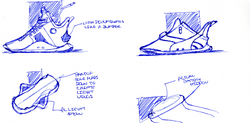Industrial Design
The systematic understanding and subsequent optimization of the human experience both physically and metaphysically
 |  |  |
|---|---|---|
 |  |
"Shift" Autonomous Car Seating Concept for GM
Working with GM, my team of designers and engineers was tasked with reimagining a seating system for passengers in an autonomous vehicle. After a few weeks of research, we determined that early autonomous vehicles would likely appear in ridesharing platforms like Lyft and Uber first. We continued to explore the future landscape to best suit as many potential users as possible. Ultimately we set out to design multiple ridesharing environments to suit different needs for different users at different times of day. The three we tackled in our time frame: Commute, Relax, and Social. Using logistical data within the ridesharing platform, the fleet of cars would be stocked based on trends in user requests for each vehicle type. All these features were designed to be controlled via an app we designed.

"What is Industrial Design?"
More people are finally starting to know the term "industrial design", but most of them are still far from truly understanding it.
Industrial Design is not merely the designing of objects, or even that of objects’ intentions. It is about defining and crafting the intentions of the entire human experience. I can say it is nothing short of a systematic understanding and optimization of our everyday experience both physically and metaphysically. It is as much about categorical efficiency as it is about innovation and progress; And it is about behavioral psych as much as it is about the altruistic balance of form and function. Often the result is beautiful to the eye, but occasionally the outcomes can be truly profound to your life. Simply put: Industrial design is the pinnacle of problem solving.
 |  |  |
|---|---|---|
 |  |  |
 |  |  |
On You: Wearing Technology at Museum of Design Atlanta
In 2016, I had the opportunity to work with Georgia Tech’s Wearable Computing Center and the Museum of Design Atlanta. With the help of Maria Fernadez Wong, I co-curated an exhibit on wearable technology from the past to the present, which was developed and assembled by Clint Zeagler and Thad Starner at Georgia Tech. We had a hand in designing the space, photographing and displaying the technology, and contracting companies to loan their gear. The exhibit featured prototypes and products from NASA, Adidas, Google, and many more.
Miura Shoes
"No More Laces"
The concept for the Miura sneakers is based on the use of a 3D printed auxetic material to replace traditional laces, offering a better fit, more support, and quicker time taking shoes on and off. The name Miura is based off an ancient Japanese origami fold that is one of the oldest auxetic tessellations.
Auxetic tessellations are based on geometric patterns that behaves abnormally compared with traditional material. These materials can be stretched in one direction and will naturally expand in the perpendicular direction. This allows for the material to fit complex shapes true to form, creating a custom fit that can be universal.
The Miura design replaces traditional shoe lacing patterns with an auxetic structural sheath. This sheath has the ability to create tension using an elastic string that can tighten the whole shoe with one pull. The elastic string runs down the length of the auxetic material and underneath your foot to offer true tension.




 |  |  |
|---|---|---|
 |  |
jellyglo Light Up Dance Shoes
For Jellyglo, a team of four students and I set out to develop a dance shoe that could be worn in any environment. We wanted the Jellyglo sneakers to be fashionable in a casual setting or at the most ostentatious of “rave” events. We developed one working prototype with a sole that reacted to your dance patterns using pressure sensors. We wanted to develop a full experience around the shoe, and developed a clear shoe box, also outfit with lights, that used induction charging to keep the sneakers charged. We built the entire shoe from scratch and even molded the sole using a 3D printed mold.
Concept Sketches
 |  |  |
|---|---|---|
 |  |  |
 |  |  |
 |  |  |
 |  |  |
 |
 |  |  |
|---|---|---|
 |  |  |
 |
Heads Up Display & Control Device
This project looked at designing a heads up display to reduce cell phone use while driving by providing on screen information. We started by looking into what activities people mostly performed while driving by using a survey, in order to see which we could prevent, or make more safe. We explored various hands free, gestural options and wearables to command the interface, but using a driving simulator, determined these could actually be more distracting or dangerous. After further testing, we determined that a small steering wheel attachment with a touch screen and a few command functions was the most beneficial option. Using the driving simulator with a prototype heads up display and control, we tested users and found our device reduced the rate of collision while performing tasks like texting, and replying to phone calls by at least 50%.















